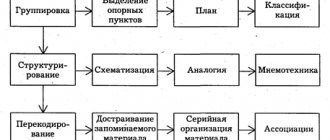Introduction
Psychology is the science of the human psyche, studying the patterns of mental phenomena. Mental phenomena are divided into three groups: mental properties, mental states and mental processes. Mental processes function directly at a given current moment in time, mental properties are the most stable psychological characteristics of a person, and mental states are short-term and occupy an intermediate position between mental processes and mental properties.
Memory is a reflection of reality, manifested in the preservation and reproduction of traces of past experience.
Images of the external world that appear in the cerebral cortex do not disappear without a trace. They leave a mark that can last for a long time.
Memorization, preservation and subsequent reproduction by a person of his experience constitutes the essence of the memory process. Thanks to memory, a person’s cognitive capabilities expand.
The main purpose of memory is to update past experiences to develop solutions to emerging problems. Memory provides a connection between the past state of the psyche, present and future actions and mental processes of a person, ensures the coherence and stability of his life experience, the continuity of the existence of consciousness and self-awareness of the individual.
If you imagine that a person loses his memory, this means that he also loses his personality. A person does not know who he is, where he is, what date it is today. He cannot speak, read, write, or use ordinary things.
Memory makes it possible to accumulate impressions about the world around us and serves as the basis for the acquisition of knowledge, skills and abilities. Considering its significance in the development of human cognition, we can say that memory is the basis of all consciousness.
Through memory, a person reacts to signals and situations that no longer directly affect him.
A person is able to accumulate information without losing previous knowledge and skills. Images of the external world that appear in the cerebral cortex do not disappear without a trace. Studies of human memory from the point of view of the ontogenetic approach were carried out by Soviet scientists P.P. Blonsky, L.S. Vygotsky, A.N. Leontyev and others. Another group of works consisted of fundamental studies of the patterns of involuntary memorization, which were carried out by such people as P.I. Zinchenko, A.A. Smirnov.
Goal: study the basic properties and various types of memory, memory processes.
Tasks:
- study the structure and properties of memory;
- memory processes;
- study the classification of types of memory.
The essence of the subject and the method of memorization.
According to the nature of the fate of the will
memory is divided into involuntary and voluntary
.
Involuntary memory
means remembering and reproducing automatically, without any effort. In this case, memorization occurs without any effort, “automatically.”
Voluntary memory refers to cases where a specific task is present and volitional efforts are used to remember.
In this type of memory, the goal plays a big role. It has been proven that material that is interesting to a person and that is of great importance is involuntarily remembered.
Definition of memory
Creating an adequate image of the surrounding world is a complex multi-level process in which cognitive processes of varying complexity take part. Each of these processes gives the image its own specific qualities.
The processes of perception and sensation give us an idea of the world as a space filled with individual objects that have shape, volume and a certain texture. Sensations give these objects qualitative features, such as color, taste, smell, heaviness, etc. Categorization processes already at the level of perception give us the opportunity in a matter of seconds to understand what kind of objects we are faced with and react accordingly. Thinking, generalizing what is perceived, unfolds the panorama of our living space, expanding it far beyond the limits of what is visible and experienced at the moment; it allows us to “see” the hidden properties of objects, understand the essence of observed events and thus anticipate their occurrence.
All this would be impossible if living beings did not have the ability to preserve: intentions, perceived impressions, the results of their processing, as well as action programs. The process that ensures the construction of a comprehensive image of the world, connecting disparate impressions into a holistic picture, the past with the present and future, is memory. Without memory processes there can be neither an objective sensory nor an abstract mental image of the surrounding world. Memory is the “cement” that connects all the building elements of the mosaic into a single picture full of life.
Psychology, having its own subject and object endowed with memory, studies the specific features of memory, i.e. those mechanisms, forms and types that a person possesses.
Memory is the process of organizing and storing past experience, making it possible to reuse it in activity or return it to the sphere of consciousness. Memory connects a subject’s past with his present and future and is the most important cognitive function underlying development and learning.
There are several levels of information storage means: physical, biological, physiological and psychological.
At the physical level, information is stored due to structural transformations carried out with physical bodies - this is the “external” memory of a person.
At the biological level, in order to preserve information, transformations occur in biological structures, such as DNA, RNA molecules, etc.
At the physiological level, information is stored and transformed on the basis of dynamic physiological processes, which differ from biological ones in their functional nature, i.e. involvement in current information processes and relative short duration.
At the actual psychological level, qualitative transformations of information, its organization and storage occur, which are based on the transformation of semantic structures, i.e. the significance and meaning for the subject of those changes occurring at previous levels that are available to him.
According to these levels, the mechanisms that take part in human memory processes are also considered, of which, in fact, only two are within the competence of psychology - physical and psychological.
Reproduction or reminiscence -, Forgetting
There are several theories about why forgetting occurs, although in practice none of them can fully explain the phenomenon of forgetting.
The theory of systematic deformation of memory traces says that changes in memory are associated with changes in brain tissue. That is, spontaneous uncontrolled changes occur in memory traces.
The theory of retroactive and proactive inhibition says that any acquisition of new material leads to disturbances in the memory of previous events. (retroactive) In the same way, any previous learning negatively affects the process of further learning and reconstruction of new material. (proactive forgetting) For example: after mathematics, it is unwise to immediately learn physics or chemistry, the process of forgetting the material will go quite quickly.
5 pages, 2041 words
Factors determining the development of memory in humans abstract on psychology
… with a person. After all, the deeper our understanding of a person, the more effectively we can serve and help him. Factors that determine the development and effectiveness of memory in humans Memorization. Memorization is a memory process at ... level [5, p425]: 1) reproducing memory; 2) recognition memory; 3) facilitating memory. Forgetting occurs unevenly over time. The greatest loss of material occurs immediately after...
The theory of motivated forgetting says that a person's goal and motivation influences forgetting. (for example, a person deliberately forgets painful information that causes pain, fear or guilt).
S. Freud devoted a lot of time to studying this particular theory and studying motivated forgetting. According to Freud, when a person involuntarily loses or pawns things, he does this in order to get rid of unpleasant memories or emotional experiences. Some common memory disorders
amnesia - i.e. absence or lapses of memory.
Depending on the processes that occur, amnesia is divided into
Physiological basis of memory
Memorizing material, storing it and then reproducing it is one of the amazing properties of our brain. It is not for nothing that I.M. Sechenov called memory “perhaps the most important miracle of animal and especially human organization.”
Excitations coming to the brain from external and internal stimuli leave “traces” in it that can persist for many years, sometimes throughout life. In the cerebral cortex, paths for excitations seem to be paved, as a result of which nerve connections subsequently arise more easily and quickly.
Connections are preserved and revived if excitations are repeated or fade away if excitations are not repeated.
Instant memory is determined by the processes occurring in the peripheral part of the analyzer. Information is stored there for a very short time - from fractions to several seconds. This process underlies the activities of cinema and television. The fact is that a person in a cinema sees not one continuous image, but a series of motionless pictures. Each subsequent image is superimposed on the memory, resulting in the illusion of movement.
Short-term memory is based on the cyclic rotation of impulses in neural circuits. An electrical signal caught in such a trap can circulate in it for some time until it is erased by the next impulse.
The duration of information storage here is from several seconds to several minutes. Therefore, having received important information, it is advisable to transfer it to a tangible medium - paper or an electronic notepad, in order to protect it from possible loss. The capacity of short-term memory is 7 ± 2 units of information, and it does not matter what is meant by a unit of information - a letter or a word. If a person has to remember a lot of information, he can enlarge units of information and combine them into blocks, thus expanding the capacity of his memory.
Most of the information from short-term memory is erased, but some of it moves into working memory. Its transition from short-term to operational is called consolidation.
This process is facilitated by certain conditions: the importance of information for the subject, repeated repetition of information, brightness, unusualness of information, as well as the presence of emotions.
In RAM, information is stored from several minutes to several hours (days), most often one day - from awakening to sleep, after which one part of it goes into long-term memory, and the other is erased. The storage period of information in RAM is related to the task facing a person. In this case, the logical processing of information received during the day occurs during “slow” sleep, and its translation into long-term memory occurs during “rapid” sleep.
Long-term memory can store information for as long as desired—throughout a person’s entire life. This process is carried out with the participation of specific memory proteins and nucleic acids. Currently, there is a hypothesis that the functioning of information in this type of memory is associated with changes in the structure of nerve cells and their electrical contacts - synapses.
Various structures of analyzers and the central nervous system are involved in the functioning of human memory. The emergence of sensory traces of information occurs in the receptor systems of analyzers.
Genetic memory, Mechanical
arbitrary, logical and mediated memory
It is generally accepted that the physiological basis of memory lies in the so-called sequential temporary connections that arise in the cerebral cortex, on conditioned reflex principles.
mental property
Another important fact: memory stores and restores very different elements of our experience: intellectual experience, emotional, and motor-motor. Memory of feelings and emotions can last even longer than intellectual memory of specific events. So, memory is a very complex mechanism; memory consists of a number of special memory factors, which we will consider.
Basic features of memory
The most important features, integral characteristics of memory, are: duration, speed (memorization and reproduction), accuracy, readiness, volume.
How productive a person’s memory is depends on these characteristics. These memory traits will be mentioned later in this work, but for now here is a brief description of them:
Volume -
the ability to simultaneously store a significant amount of information. The average memory size is 7 elements (units) of information.
7 pages, 3362 words
Test: “Man in the social dimension”
... b. – “4” 13– 9 b. – “3” less than 9 points. – “2” Test on the topic: “Man in the social dimension.” 6th grade 2nd option Part I. (choose one correct answer - 1 point. Total... 10 points) 1. The main differences between humans and animals: 1) caring for offspring 2) ...
Speed of memorization
- varies from person to person. The speed of memorization can be increased with the help of special memory training.
Accuracy - Accuracy is demonstrated by recalling facts and events that a person has encountered, as well as recalling the content of information. This trait is very important in learning.
Duration is the ability to preserve the experience over a long period of time. Also a very individual quality: some people can remember the faces and names of school friends many years later, some forget them after just a few years. The duration of memory is selective.
Readiness for reproduction is the ability to quickly reproduce information in the human mind. It is thanks to this ability that we can effectively use previously acquired experience.
Processes and types of memory
Memory processes
Memory processes include memorization, storage and forgetting, and recall.
Memorization. The memorization process is an active process in which some actions are performed with the source material. The process of memorization begins in short-term memory and ends in long-term memory. In this case, the following sequence of actions occurs.
Only that material that is identified by comparing the actual sensory image with standards stored in long-term memory enters short-term memory from sensory memory. After a visual or acoustic image has entered short-term memory, it is translated into the language of auditory speech and continues to exist in it mainly in this form. During the process of this transformation, the material is classified based on semantic features to be sent to the appropriate department of long-term memory. In reality, this process is even more complex and represents the establishment of semantic connections between the received material and semantically related generalizations stored in long-term memory. In this case, a transformation occurs not only of the available material, but also of the structures of long-term memory. Once these connections are established and reinforced, the material remains in long-term memory “for eternal storage.”
Storage and Forgetting. Storage means the presence of information in long-term memory, which is not always associated with its accessibility to consciousness. Forgetting is a heterogeneous process; it can take a wide variety of forms. A person, for example, cannot remember what happened to him in early childhood, because before mastering speech he could not transfer for storage in symbolic form what he perceived in figurative form. Forgetting can also mean that a person “forgets” to do something that was planned earlier, for example, buy something in a store. Forgetting may also be associated with physical traumatic brain injury, or may be due to the so-called repression - involuntary forgetting of events that cause mental pain. In this regard, forgetting in psychology refers to everything that happens when material that was once remembered and which then needs to be found cannot be retrieved from memory.
Reproduction of material stored in long-term memory involves transferring it from long-term memory to short-term memory, i.e. in its actualization in consciousness. Reproduction depends on the processes of memorization and forgetting, but it also has its own characteristics and mechanisms. Reproduction can take three forms: recognition, recollection and recollection. The meaning of recognition is clear without much explanation; it is associated with the conscious identification of images. Recall is a complex memory process that involves searching for required material in long-term memory.
There are episodic and semantic memory. Reproduction of events from episodic memory may have particular vividness precisely due to the fact that when they are memorized, material is stored in memory that relates not only to various modalities, but also to the emotions and actions experienced at that moment. In addition, it is localized in a specific place and time. All this makes it more meaningful and distinguishes it from knowledge obtained indirectly. Reproduction of such personally experienced images is called memory.
However, all these processes are usually considered together as representing a single human memory system.
Types of memory
Emotional memory. A person's emotions are closely related to his needs or motives, since they reflect the relationship between needs and features of the situation that promote or hinder their satisfaction. Emotions act as signals about the extent to which our needs are or can be satisfied. Since an emotion is a signal, it can be stored in memory in one or close to the form that accompanied the events experienced for the first time. When re-perceiving or imagining a situation that caused an emotion, its assessment as desirable or, conversely, threatening, can be made due to the immediate appearance of the emotion stored in memory. This assessment allows us to construct appropriate behavior even before the situation is comprehended and analyzed through thinking.
Figurative memory stores experiences in the form of images. Figurative memory is the essence of representation. In the form of images, memory stores not only impressions accessible to consciousness, obtained through the senses, but also unconscious images, such as standards or patterns (a stable pattern of behavior of living individuals), which take part in perception processes, for example, in pattern recognition.
Our mental images of the world are stored in verbal-logical memory in the form of generalized categories, judgments, abstract conceptual schemes and, finally, the worldview as a whole. In addition, consciously planned activity programs are also stored in verbal-logical form.
Motor memory stores patterns of various movements and their systems, forming motor skills that ensure the automated nature of actions in repetitive or typical situations. It is motor memory that allows us to think about something extraneous at the moment when we open the door to our own apartment.
All types, or components, of memory are closely related to each other, since they are components of a single, integral behavioral act.
Other characteristics of the thought process
Specific principles of memorization are associated with personality characteristics. Even people with excellent memory do not retain everything in their minds, and those with short memories do not forget a lot of information.
Individual characteristics
The period of storage of information in the long-term stage is compared with the lifespan of the organism. A person interested in acquiring new knowledge or actions remembers events for a long time. Memory is part of learning, prediction and personal consciousness.
A person has an excellent memory if he instantly remembers the material, the information is recorded for a long time and is not forgotten, and then accurately reproduced.
The optimal is rapid memorization with leisurely forgetting, slow assimilation of information with fleeting forgetting . For example, artists or other people in the creative profession have a well-developed emotional memory, musicians have a well-developed auditory memory, artists have a visual memory, and philosophers have a well-developed verbal-logical memory.
The development of the memory function of the brain depends on the professional activity of the individual, since the psyche is manifested and formed in work. Some citizens need visual, auditory or verbal perception to remember information.
The type of memory represents the personal characteristics of each person. Belonging to a type is determined by the practice of memorization - by what a given person has to remember and how he learns to do it. Memory can be developed, educated and trained with special exercises.
Positive results from the use of psychopharmacological medications that activate brain activity can be expected in people with a stable, balanced psyche, as well as inert, low-initiative, and unconfident individuals.
The formation of positive memory properties is facilitated by the rationalization of the intellectual and practical work of citizens : order in the workplace, planning, self-control, the use of reasonable methods of memorization, a critical attitude towards personal activities, the ability to abandon ineffective work methods.
Protecting the brain from unnecessary information explains the phenomenon of hypnopaedia - learning in a dream. In a state of sleep, certain mechanisms that protect the brain from unnecessary information are turned off, so memorization occurs faster.
List of used literature
- Maklakov, A.G. General psychology: Textbook for universities. – St. Petersburg: Peter, 2007. – 583 p. – (series “Textbook of the New Century”)
- Nemov, R.S. Psychology: Textbook. – M.: Higher Education, 2007. – 639 p. – (Fundamentals of Sciences)
- Psychology: Textbook for pedagogical universities / ed. B.A. Sosnovsky. – M.: Yurayt-Izdat, 2005. – 660 p.
- https://psy.wikireading.ru/28659
- https://psihomed.com/pamyat/
- https://impsi.ru/general-psychology/pamyat-obshhaya-harakteristika-vidy-protsessy-i-mehanizmy/
- https://psychologist.tips/646-vidy-pamyati-v-psihologii.html
- https://static.my-shop.ru/product/pdf/304/3032928.pdf
- https://yandex.ru/turbo/psylogik.ru/s/210-vidy-pamjati-v-psihologii.html
- https://yandex.ru/turbo/psylogik.ru/s/210-vidy-pamjati-v-psihologii.html
- What is a neural network? (Types of neural network architectures)
- Business Process Management, Workflow
- International currency liquidity (Faculty of Economics)
- Financial and management accounting and analysis: comparative characteristics.
- Microkernel operating systems (Abstract on the discipline “Operating Systems”)
- Founder's business (JSC)
- Guarantees of constitutional rights and freedoms in the Russian Federation
- Styles of pedagogical communication
- Concept of KIP
- Electronic document (Concept of electronic document management)
- Theories of teaching
- General characteristics of pedagogical activity (General characteristics of pedagogical activity)
Some universal principles in the memory mechanism
These facts were obtained by researchers based on different theories of memory. The German scientist G. Ebbinghaus generalized and derived some patterns in the memory mechanism:
when memorizing material, its beginning or end is best reproduced (“edge effect”)
Memorization will be better if you repeat the material several times over a period of time: several hours or days
Any repetition helps to better remember what was learned before. Repetition generally plays a big role, and, as was said, not mechanical, but logical processing of the material.
These are some of the most general, but not at all exhaustive, patterns of memory functioning in humans.
Literature
[Electronic resource]//URL: https://psychoexpert.ru/referat/geneticheskaya-pamyat-v-psihologii/
3 pages, 1374 words
How to choose a topic for an essay on psychology
Writing essays on psychology is an important stage in the professional training of students, as it helps improve the quality of mastering program material, in-depth understanding of the most complex issues of the course and mastering the structure of describing psychological research. But …
1. Gamezo M.V., I.A. Domashenko, Atlas of Psychology, 3rd edition, Moscow, 1999, p. 159
2. Krylov A.A., S.A. Manicheva, General Workshop. Experimental and Applied Psychology, "Peter", St. Petersburg, 2000, p. 89
3. Maxelon Yousef, Psychology, 1998, p. 125
4. Maksimenko S.D., V.O. Solovyanenko, Zagalnaya psychology, MAUP, Kyiv 2000
5. Nemov R.S., General fundamentals of psychology, book 1, “Enlightenment”, Moscow, 1994, p. 184
6. Jaspers Karl, General psychopathology, "Practice", Mosca 1997, p. 218
7. Shatalov V.V. Memory and the possibilities of its development, Kyiv 1997, p. 120
8. Gippertainer, Fundamentals of Psychology, Moscow 1988, p. 150
Examples of similar educational works
The contribution of cognitive psychology to the problem of studying human memory
... and memory development. The object of study of this work is cognitive psychology. The subject of the research is the study of memory. The purpose of the work is to consider various aspects of the study of memory in cognitive psychology. Achieving the goal...
Ways, techniques and means of improving human memory
... while writing my essay, I used such sources as “Improving memory - at any age,” a book by American researcher Danielle Lapp contains simple, accessible recommendations for developing and activating memory and effective ...
Types of human memory abstract on psychology
... types of memory exist in all living beings, although at varying degrees of development. But a person... what has been in psychology for a long time... is a type of memory: genetic and mechanical. — Genetic memory is a memory that is stored in the genotype, transmitted and reproduced by ...
Daily life of Soviet people based on materials from the Soviet press
... previous periods: propaganda of the USSR as the most progressive society of developed socialism was promoted. 3. The image in the media of an advanced Soviet man and his life in an industrial city. The life of a Soviet man was...
Properties of memory in psychology
... they differ only in the strength of associations. Therefore, this interpretation of memory is called monistic. Another interpretation of memory was developed in the psychology of consciousness (W. James). Memory here is dual (primary and secondary). Primary…







